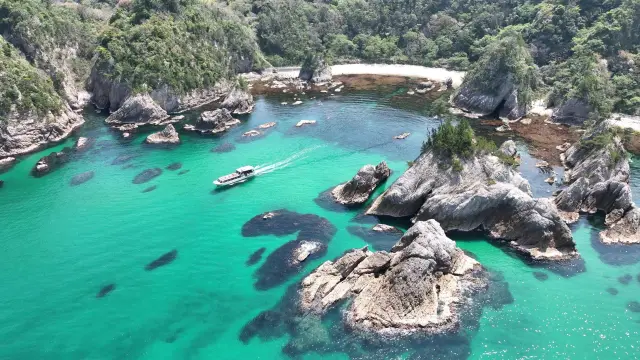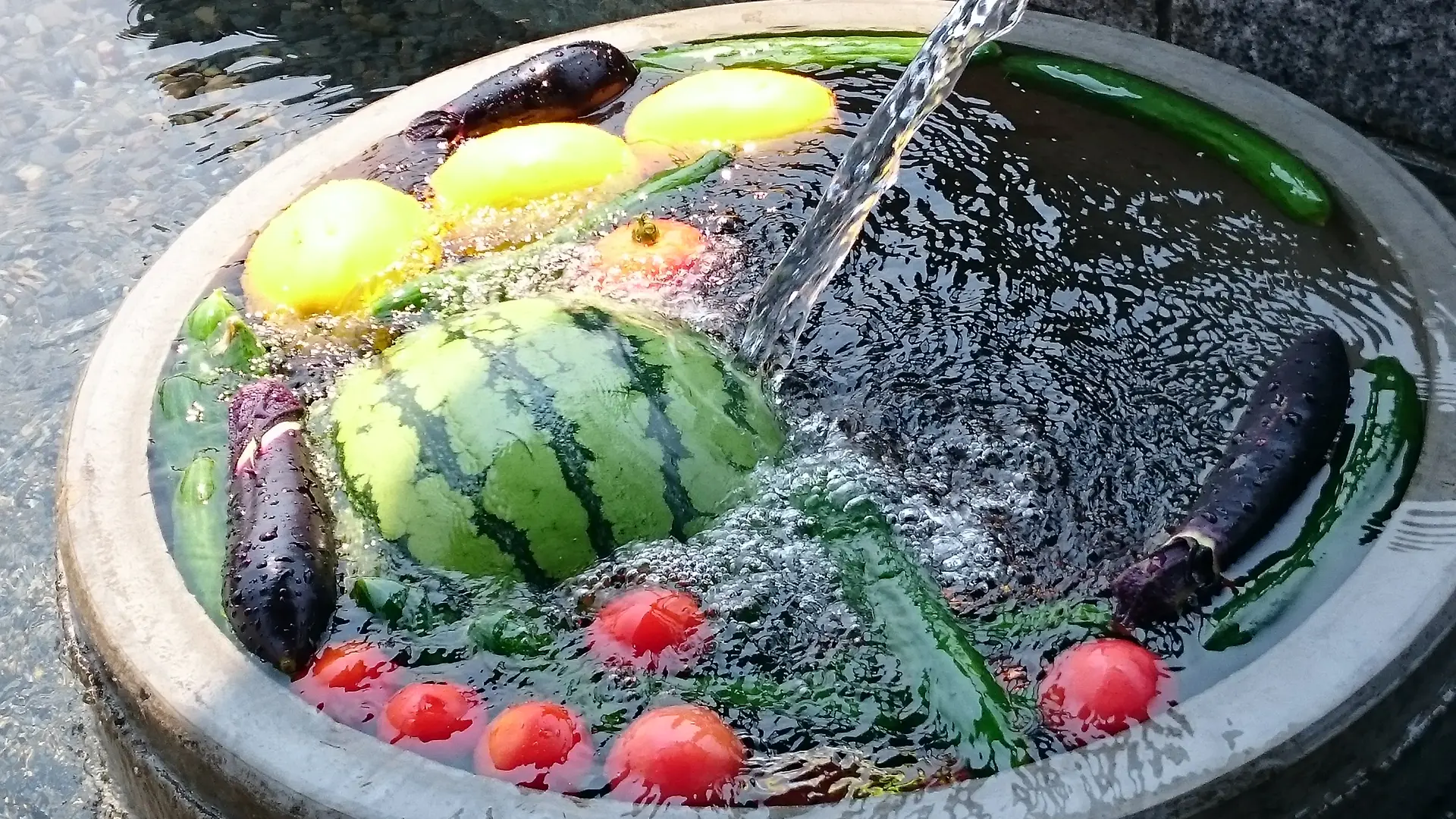
Shiga: Days Steeped in Nature and Blessed Waters Along Lake Biwa
Last update
Near the heart of Japan inside of Shiga Prefecture sits Lake Biwa, the country’s largest freshwater lake, covering approximately one-sixth of the prefecture’s land area. The massive volume of water nurtures and equally rich natural landscape and colorful repertoire of foodways that intertwine with the region’s deep historical narratives.
This roundup details a 1-night, 2-day journey that kicks off with a tour of Takashima City and a focus on Harie, a village known for its pure spring water (Shōzu no Sato). The second day reveals a full roundup of activities and history surrounding Lake Biwa, offering a full-packed menu of experiences that celebrate the blessings of water.
Table of Contents
DAY1
7:47am – Kickoff from JR Osaka Station
Start off by departing JR Osaka Station via the JR Kyoto Line, heading toward Shiga Prefecture. Peer outside the window for a view that slowly melts away into the vibrant sway of natural landscape. By this time, the train has switched to the JR Kosei Line, which runs along the western shore of Lake Biwa.
An easy train stop at Makino Station, the northernmost station in Takashima City, means its time to hop on the Takashima City Community Bus to start
10:14am – A Grand Stroll Down Metasequoia Avenue
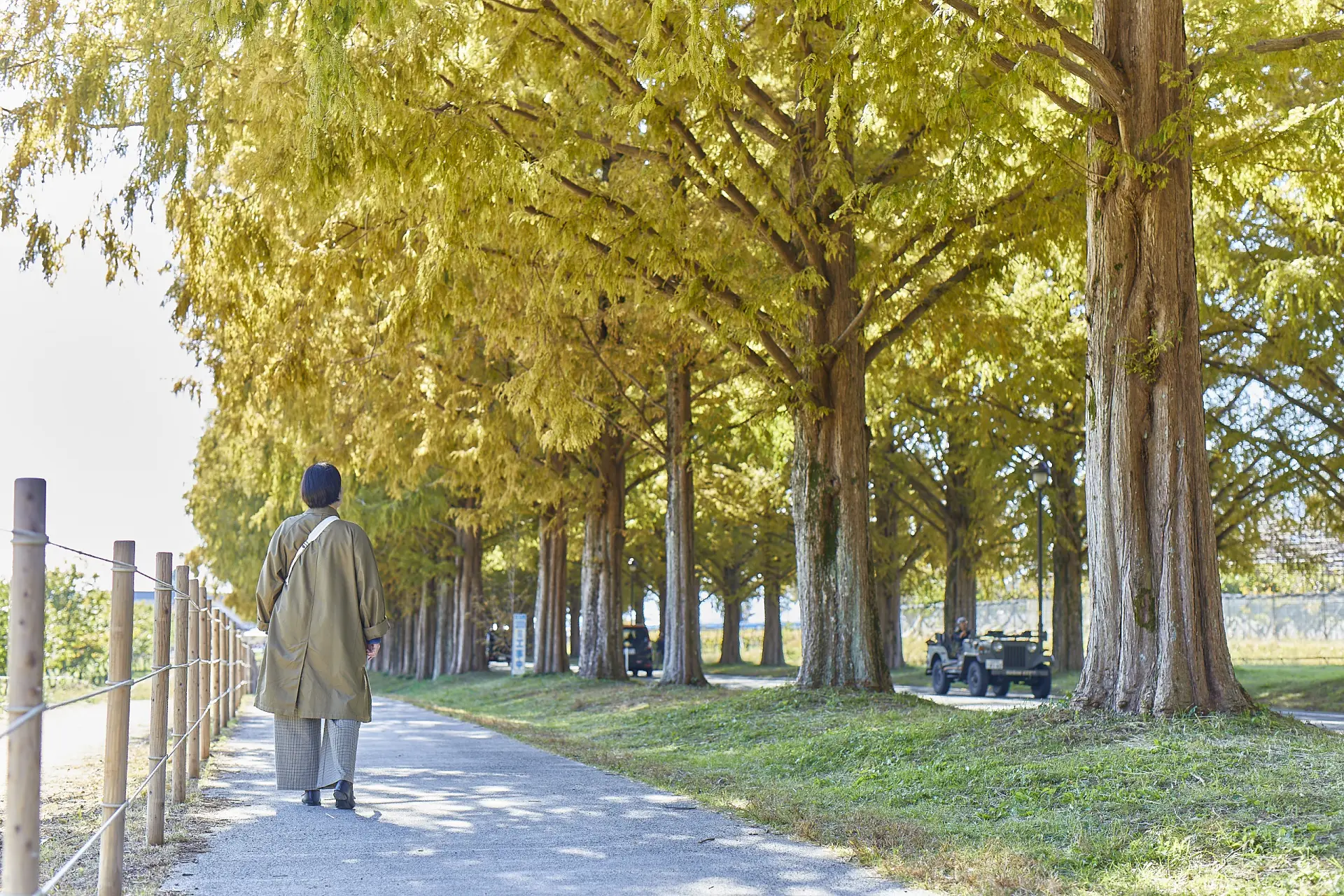
Step through what feels like a tunnel made entirely of metasequoia trees.
Get off the bus at the "Makino Pickland" stop and walking for about 10 minutes to arrive at your first destination, Metasequoia Avenue.
The Metasequoia Avenue, as it is widely known, refers to a scenic stretch of Prefectural Route Koaraji-Makinozawa, which runs north to south through Makino Pickland, an agricultural park offering fruit picking and other seasonal activities. The 2.4-kilometer road extends with, approximately 500 metasequoia trees along its side, in a breathtaking natural corridor.
The avenue traces its origins back to 1981, when the Makino Town Fruit Producers’ Association first planted the trees. Over time, the local community nurtured and expanded the planting efforts, shaping the spectacular landscape we see today. This vast and awe-inspiring sight feels like a testament to the deep respect the community holds for its natural surroundings.
A visit in November brings the delight of a mesmerizing golden canopy, with leaves shimmering in the sunlight as you recharge with each step below.
As autumn deepens, the foliage transforms into a vivid crimson, while in winter, the trees stand gracefully against a snow-covered landscape. In early summer, fresh, vibrant greenery breathes new life into the scene. Each season brings its own distinct beauty, leaving visitors eager to return and see what enchanting colors await next time.
Details
- Name in Japanese
- メタセコイア並木
- Postal Code
- 520-1833
- Address
- Hiruguchi to Makino, Makino Town, Takashima City, Shiga
- Telephone
- Makino Agricultural Park Makino Pickland 0740-27-1811
- Access
- Approx. 6 minutes by bus from JR Kosei Line Makino Station, get off at "Makino Pickland", then walk about 10 minutes.
- Admission
- Free
12:30pm – A Tasteful Spread of Shinasahi’s Local Cuisine over Lunch at Ikiiki Mizubunka Kabata-kan
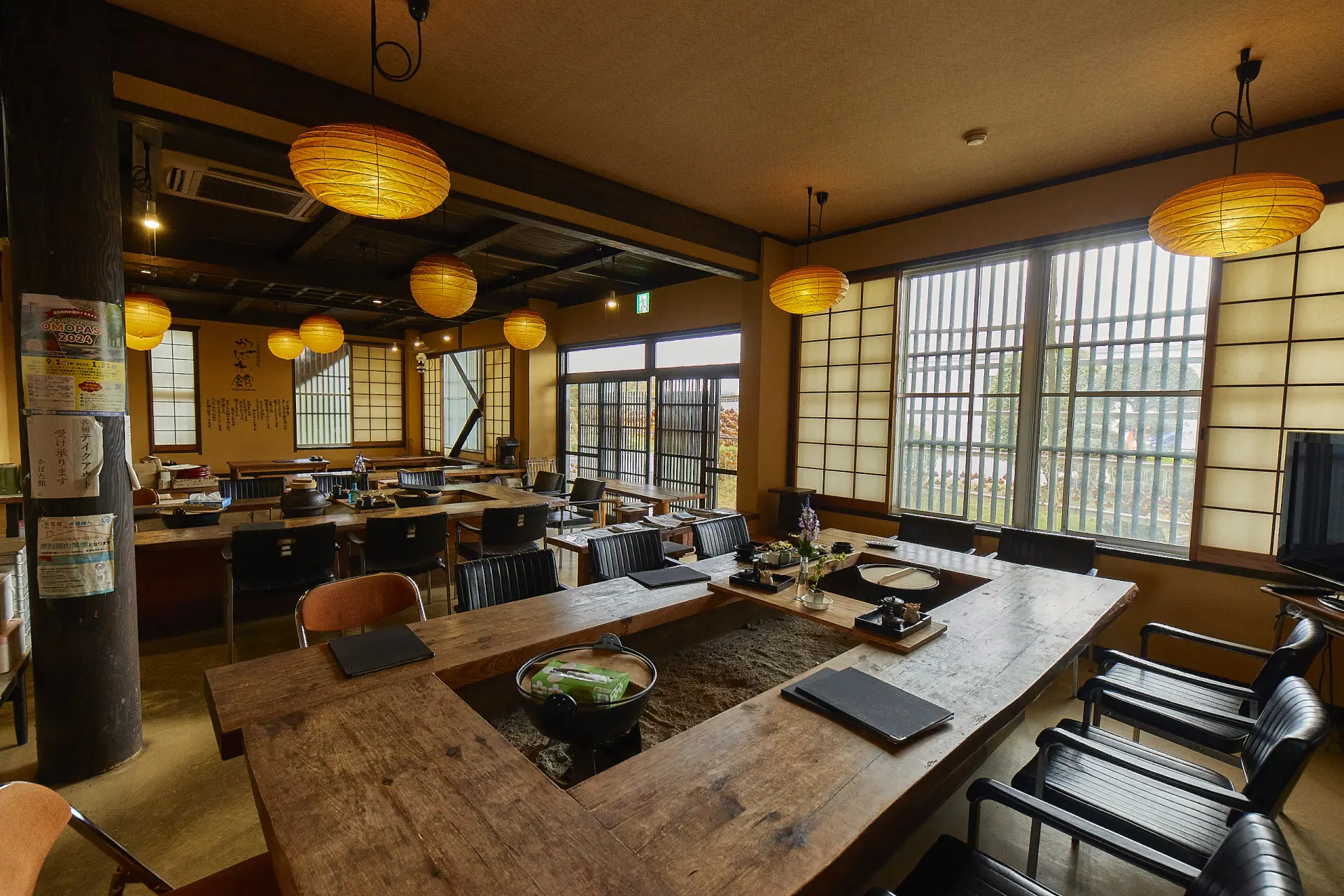
The interior glows with old-time Japanese flair, complete with an “irori” sunken hearth.
Head back to Makino Station to board the Shinkaisoku (Special Rapid Service) and head slightly south along the JR Kosei Line, getting off at Shinasahi Station. With a quick 15-minute walk you’ll land at the day’s much-anticipated lunch destination.
Ikiiki Mizubunka Kabata-kan is run by the local Chamber of Commerce women's group, dedicated to preserving and sharing Shinasahi’s traditional flavors. Step inside to find a space that hums with the nostalgic flair of a traditional Japanese house and a sense of familiar welcome that draws you in like home.
The crowd favorite here is the "Tonchan Set Meal" (1,200 yen), featuring Takashima City's specialty. The Tonchan—tender chicken marinated in miso and grilled to perfection—is incredibly juicy, bursting with umami that keeps you wanting more.
For the rice, take your pick between white rice or Shoi-meshi, a fragrant, soy sauce-seasoned takikomi-gohan (seasoned rice). The Shoi-meshi is prepared using the "Yudate-shiki" method, a traditional boiling-water cooking technique passed down in Shinasahi for enhanced, hearty flavor.
Ingredients are carefully selected from local produce nurtured by the natural environment of Lake Biwa, and each dish is prepared using time-honored cooking methods that bring out the best in the ingredients. Sink your teeth in and get to known the region’s essence with the joy of all five senses.
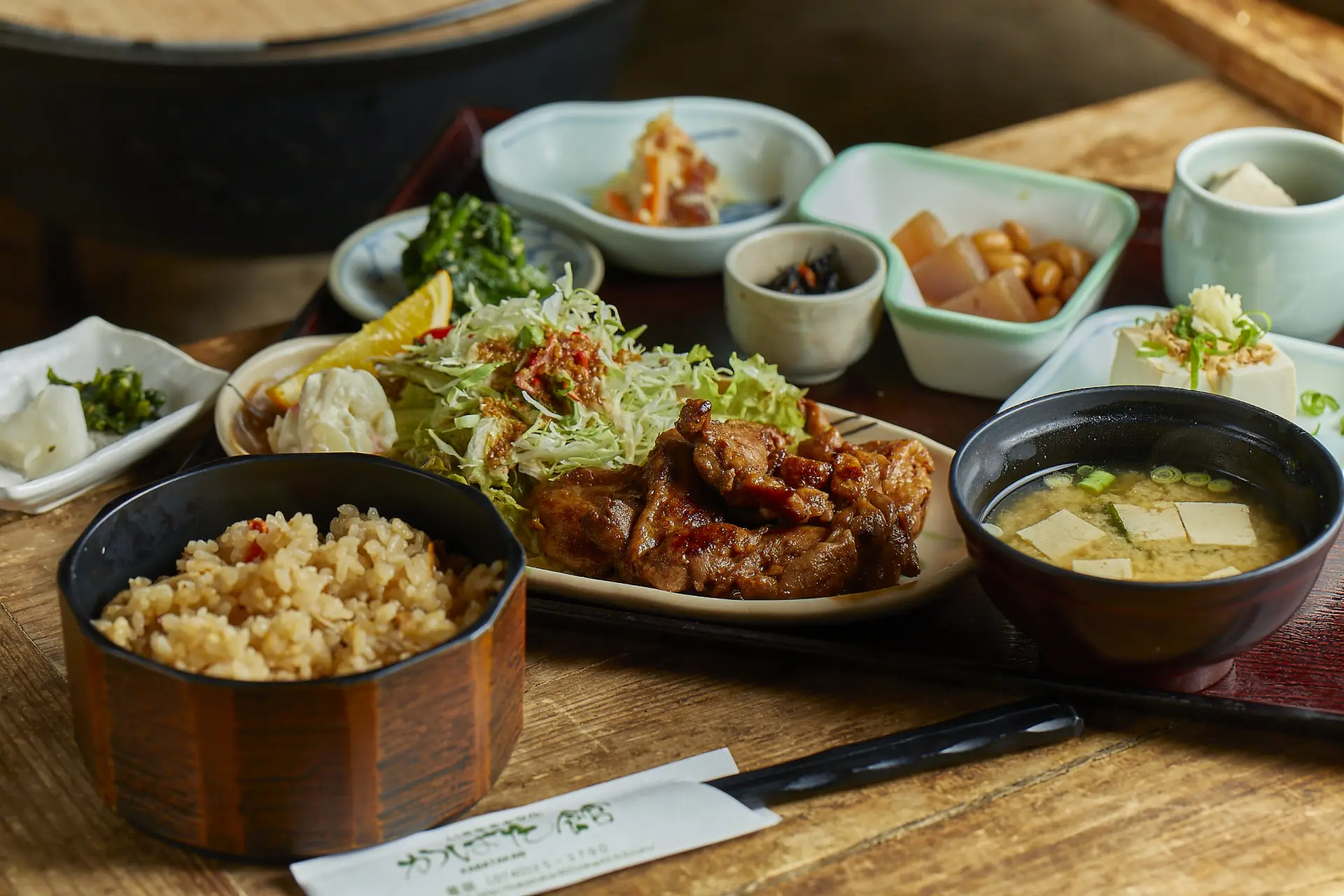
Big flavors and even bigger portions via plate sets that celebrate the utmost of local-sourced ingredients.
In addition to the "Tonchan Set Meal", the restaurant offers a wide variety of lunch options and an extensive café menu. The cozy and inviting atmosphere makes it a place where you’ll want to linger and relax, leaving you eager to visit again.
Details
- Name in Japanese
- いき生き水文化 かばた館
- Postal Code
- 520-1501
- Address
- 707 Shinasahichoasahi, Takashima City, Shiga
- Telephone
- 0740-25-3790
- Access
- Approx. 15-minute walk from JR Kosei Line Shinasahi Station
- Hours
- 11:00am - 4:00pm, dinner by reservation only
- Closed
- Wednesdays and New Year holidays
- URL
- URL
1:30pm – Discover the Essential Role of "Kabata" in Daily Life on the "Living with Lake Biwa: Harie Shozu-no-Sato Kabata Tour"!
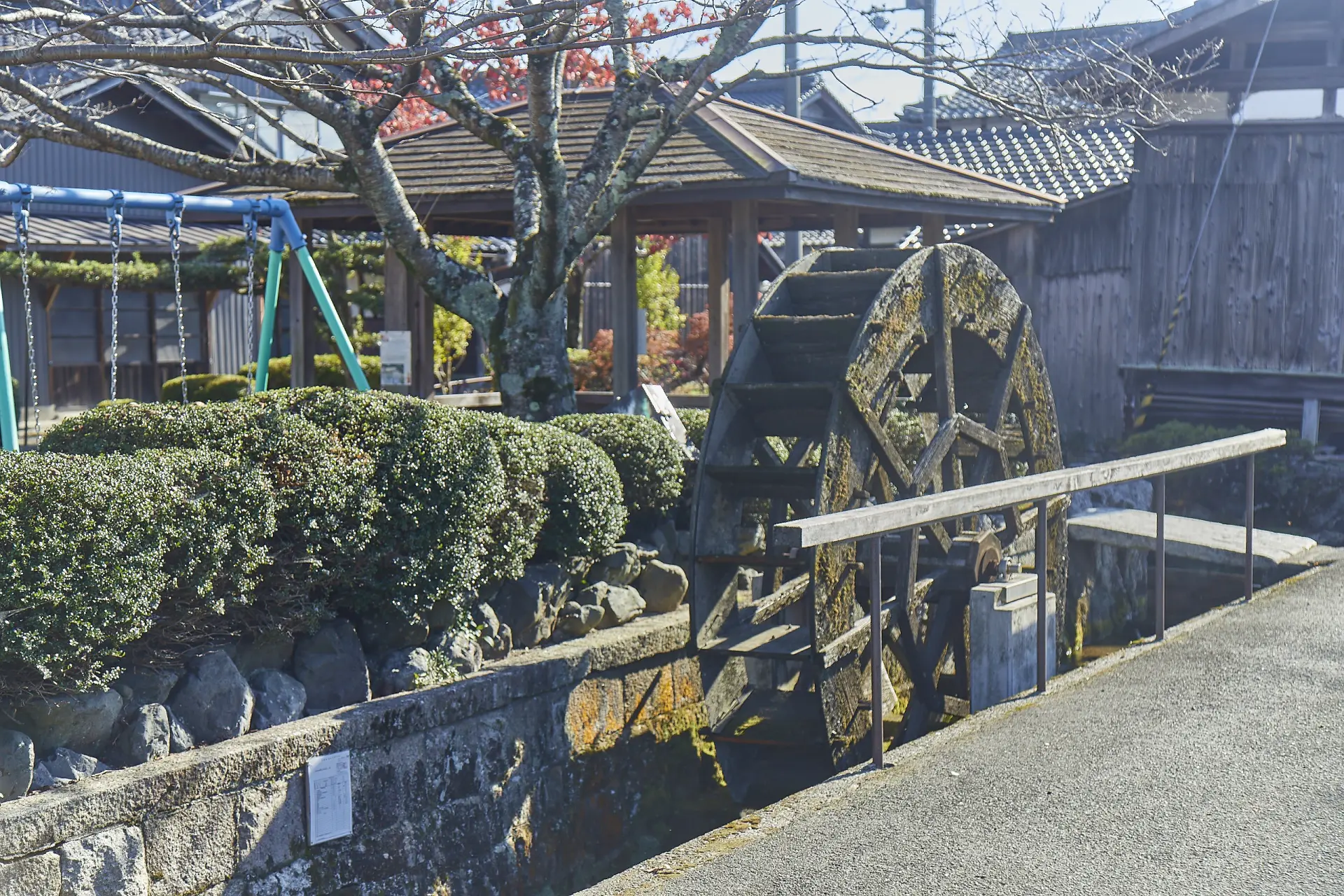
Storybook beauty unfolds as the waterwheel turns in the tranquil heart of Harie near Chuo Park.
Next up is an easy 15-minute jaunt from Ikiiki Mizubunka Kabata-kan to Harie Community Center.
After a smooth check-in at reception, found just left of the entrance, it’s time to set off on the "Kabata Tour", guided by a savvy local expert.
A Kabata is a natural spring water system found in individual households, where fresh water continuously bubbles up and is used for daily life. This unique water system, written as "川端" (Kabata), has been an integral part of traditional sustainable living.
In Harie, the pristine spring water that flows through these systems is known as "Shozu" (生水), and its purity has earned it a place among the "Heisei 100 Famous Waters". While similar Kabata systems once existed across Japan, Harie remains one of the few places where they are still actively used and can be experienced firsthand through guided tours, making it an incredibly rare and valuable cultural heritage site.
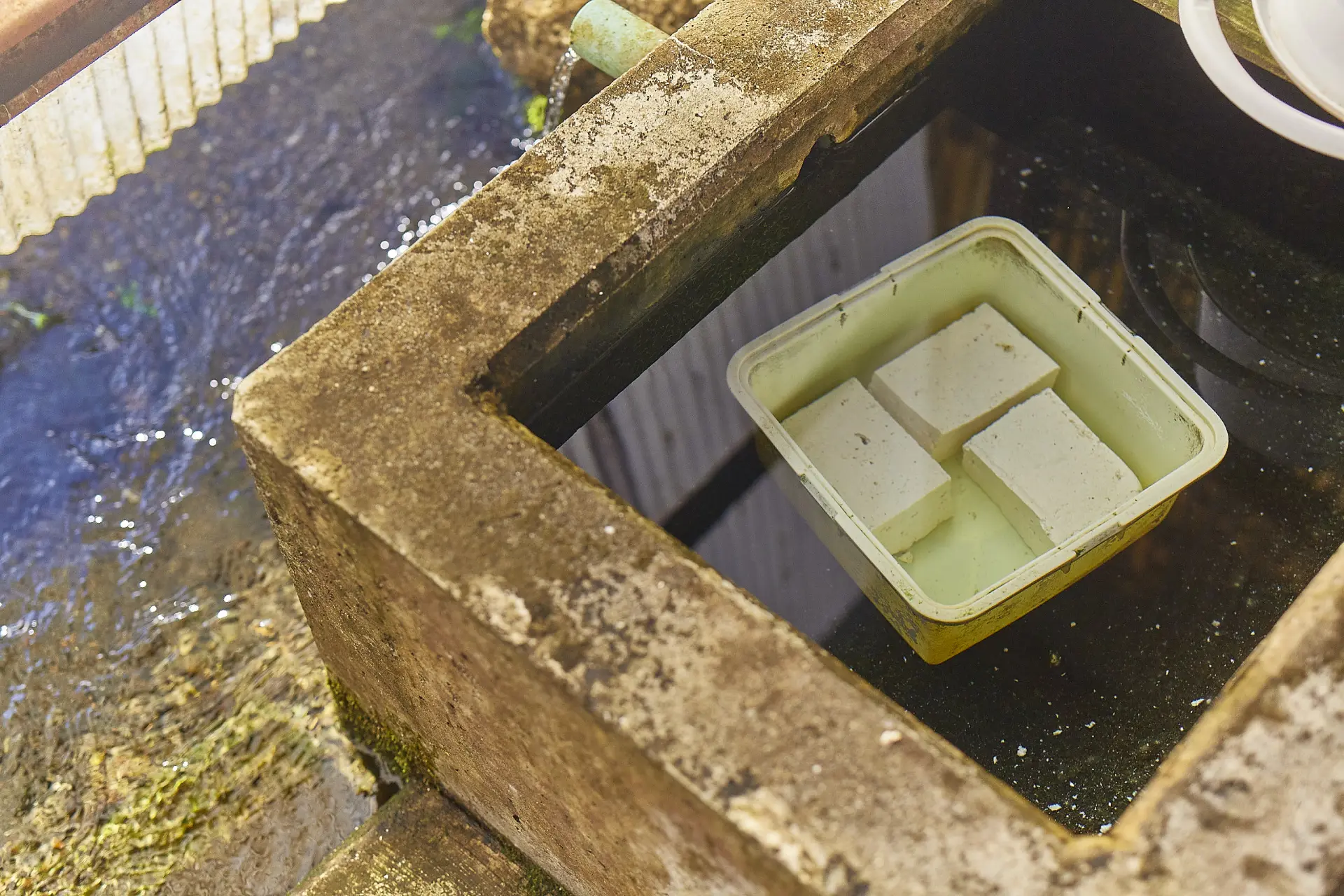
Tofu chilled in the fresh spring water of a kabata. It also doubles as a hub for food prep.
Hear the fascinating ways Kabata interplays in daily life—from cooking and drinking water to chilling ingredients—enjoy this glimpse into the traditional way of life in Japan. Along the way, there’s a welcome invitation to taste the fresh spring water and see for yourself how its smooth, mellow texture feels like nature’s gentle gift and refreshment. Seeing how the people of Harie live with such pure, abundant water right at their doorstep, many visitors come away just a little envious.
The Harie-Ōkawa River, which flows through the center of the district, along with its network of waterways, is so crystal clear that we can see straight to the bottom. Take a close watch and spot Yoshinobori (freshwater gobies) swimming gracefully. There’s even clusters of Baikamo, an aquatic plant that thrives in pure, flowing water, further highlighting the pristine environment of this unique village.
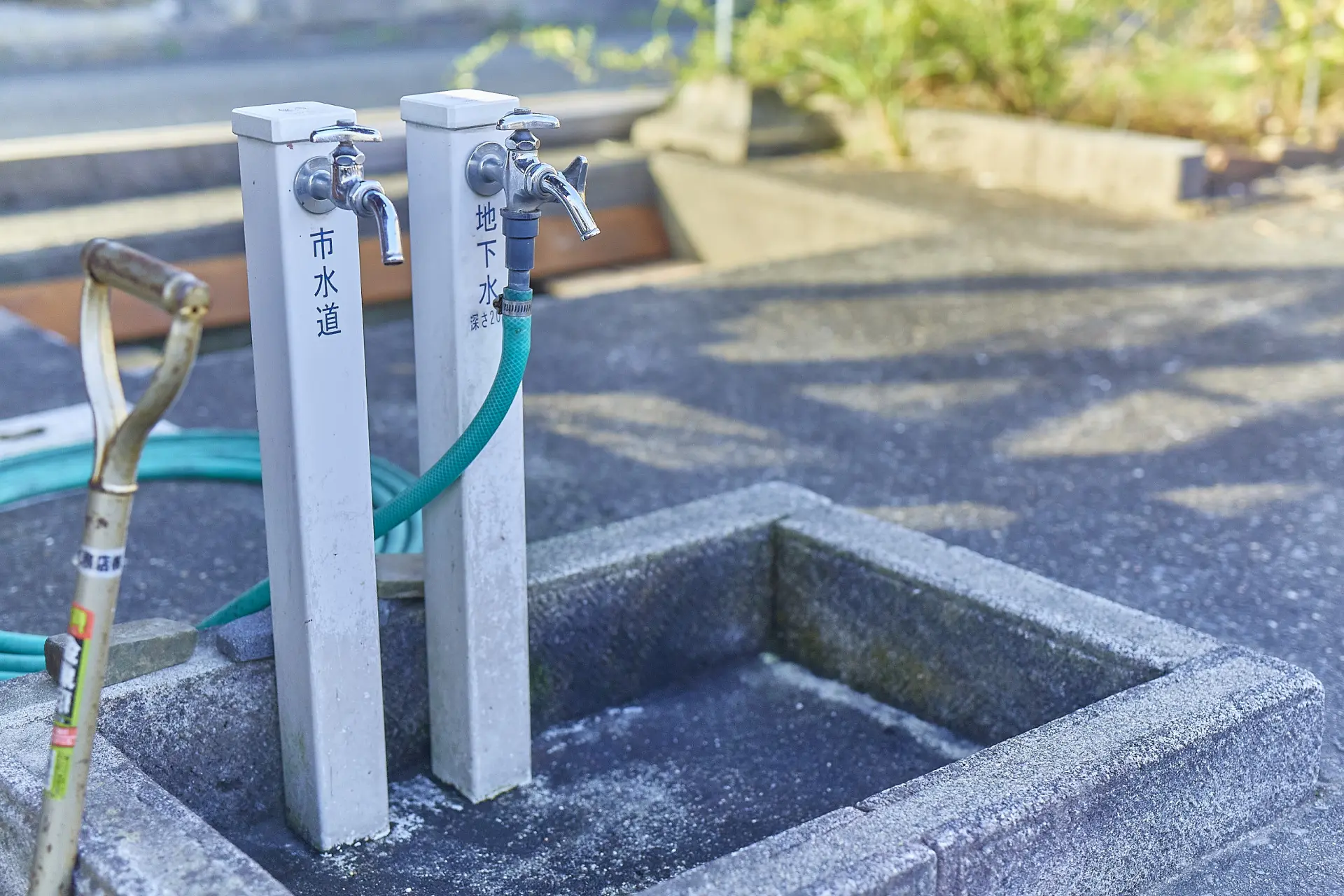
Dedicated flight tasting to compare the city tap with Harie's natural groundwater.
Next up are visits to Osakana Asahi, a fish processing and sales shop, and Uehara Tofu Shop, where spring water is used in tofu-making. The stops offer a deep dive look into how pure spring water nurtures local food culture.
The final stop on the tour’s course leads to Shōden-ji Temple and chance to observe Kamegaike Pond adorned with stone statues. See as the natural spring water bubbles up from the pond’s surface, shimming with the vital life force that brings water to the region’s lands.
The one-hour tour seems even quick thanks to the riveting details from the guide, offering a captivating look into fascinating stories and insights along the way.
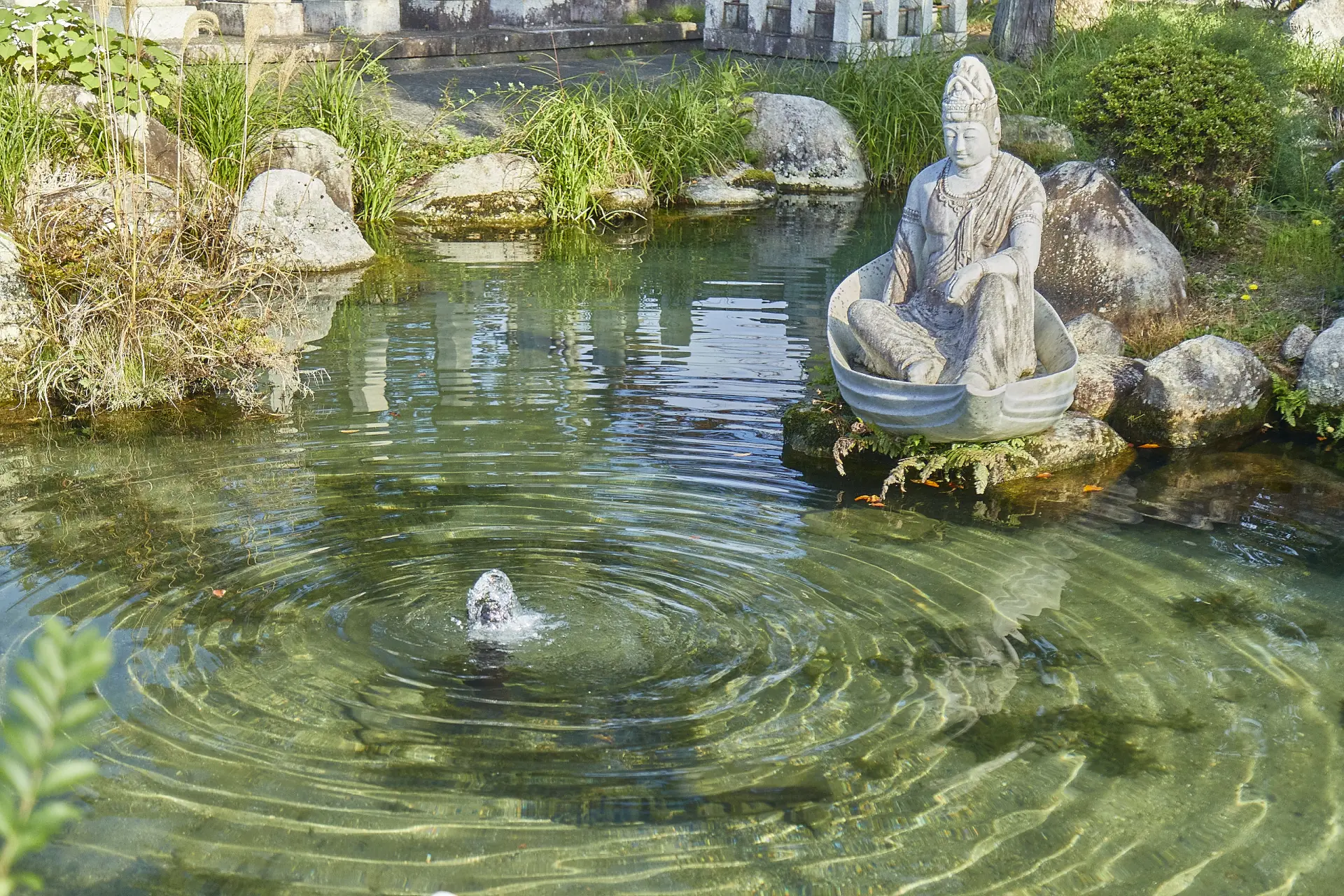
The spring water of Kamegaike Pond, watched over by a stone statue of Yakushi Nyorai (the Buddha of Healing), is one of the tour’s highlights.
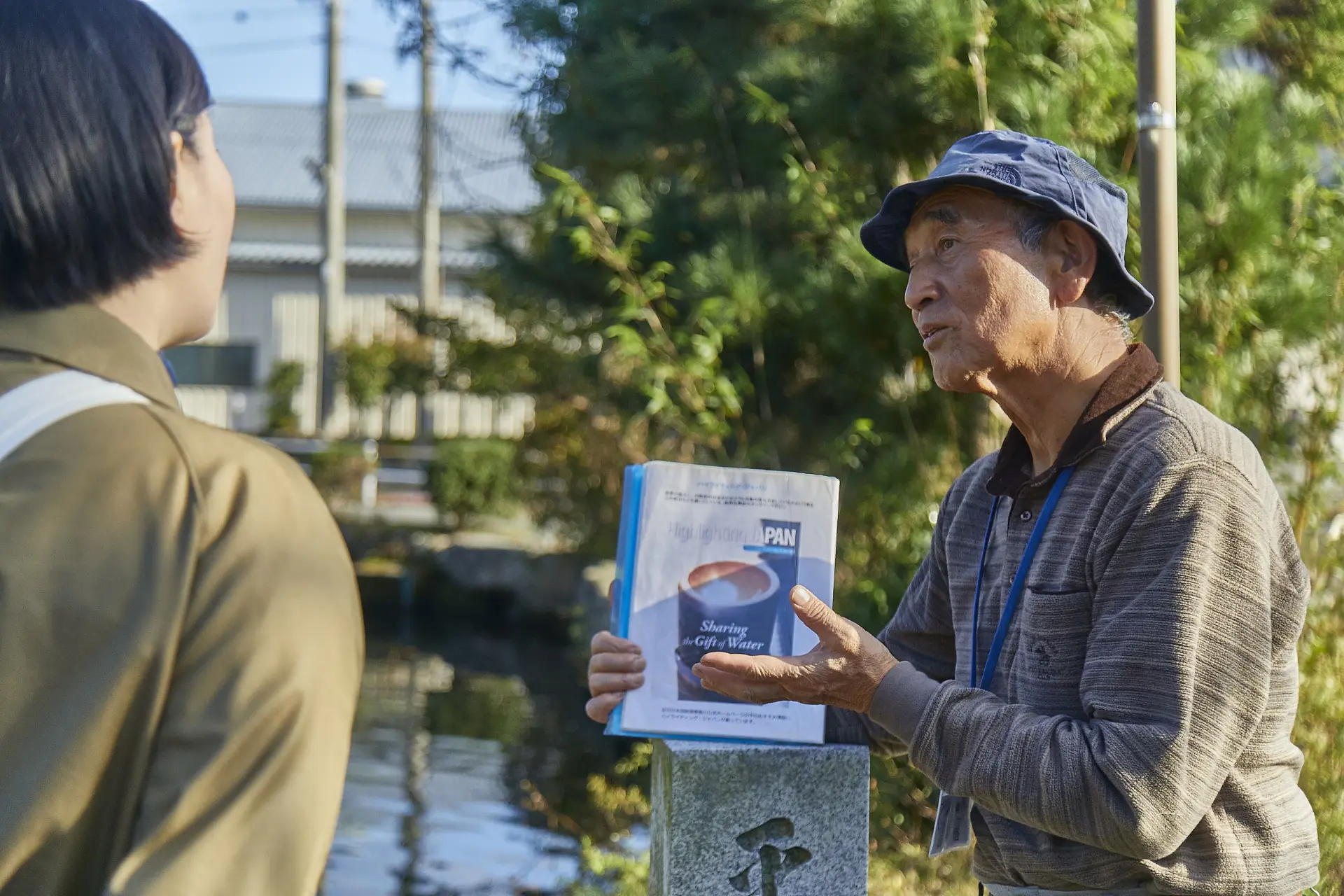
Engaging deep details from a lively guide, dedicated materials and an undeniable sense of humor.
Details
- Name in Japanese
-
Life by Lake Biwa: Village of Harie Shozu no Sato “Kabata Tour”
針江生水の郷「かばた見学」ツアー - URL
- URL(English)
- Notes
-
・The Kabata in Harie are private household facilities and are not accessible outside of this guided tour organized by the committee.
・Those wishing to join the tour must make a reservation at least one week in advance. Tours are held twice daily, starting at 10:00am and 2:00pm, with a fee of 1,000 yen per adult.
・The tour does not operate on Mondays, during the New Year holidays, or on local event days.
・There is no parking available within the village. Parking instructions will be provided upon check-in for those who have reserved a tour.
・The tour is primarily conducted in Japanese, but English-speaking guides may be available upon request. Please inquire in advance if you require an English guide.
5:15pm – Savor Exquisite Ōmi Beef with a Stunning View of Lake Biwa at Biwako Hotel
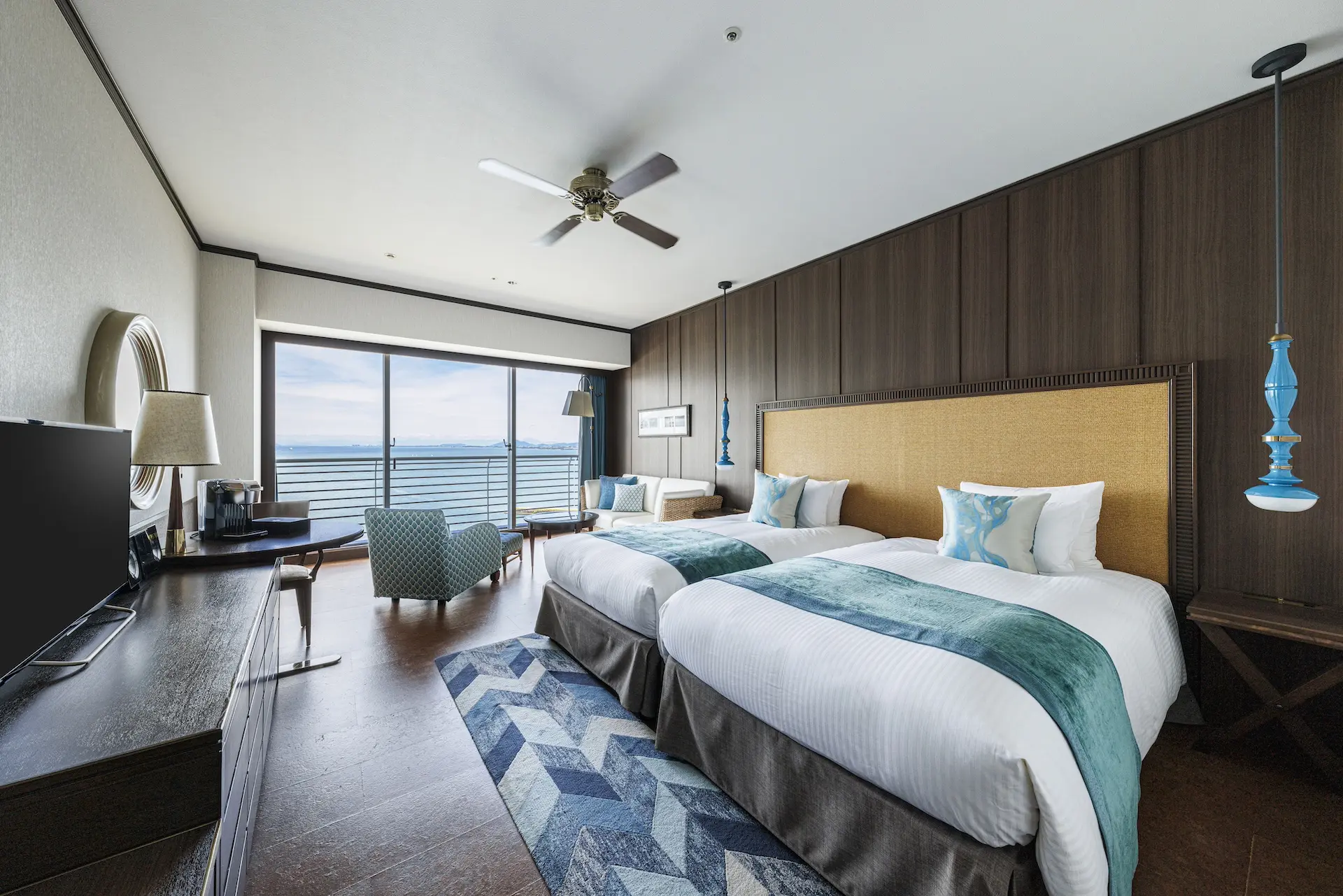
Unparalleled lakeside experience and unmatched views of Lake Biwa from every room.
As the mini-tour ends it’s time to board the Shinkaisoku (Special Rapid Service) on the Kosei Line from Shinasahi Station and head to JR Ōtsu Station. From there, it’s time to head to a prebooked stay at the renowned Biwako Hotel.
As a lakeside resort, Biwako Hotel is known for its stunning waterfront views, a sight that only gets more tantalizing as you approach.
One of the highlights of our stay is the exquisite dining experience. On this exclusive stay plan meals include a treat of Ōmi Beef, one of Japan’s three most famous wagyu varieties. Raised in the lush, natural environment along the shores of Lake Biwa, Ōmi Beef is known for its tender texture and subtly sweet, non-greasy fat. Cooked to perfection on a teppanyaki grill, bite in for a sumptuous time of luxe flavor.
As the day winds to a close, tuck in for a night hugged by tranquil lakeside scenery and a chance to recharge after the day.
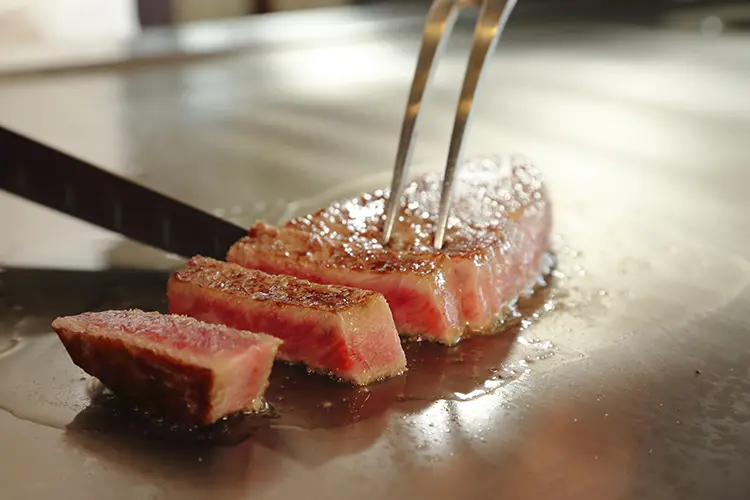
Ingredients sourced with a commitment to local production for local consumption are prepared and served at a teppanyaki counter, offering a dynamic and immersive dining experience.
Details
- Name in Japanese
- 琵琶湖ホテル
- URL
- URL(English)
DAY2
9:10am – Explore Lake Biwa’s Rich Natural Diversity on the "Eco-Blue Adventure Kayak Tour"!
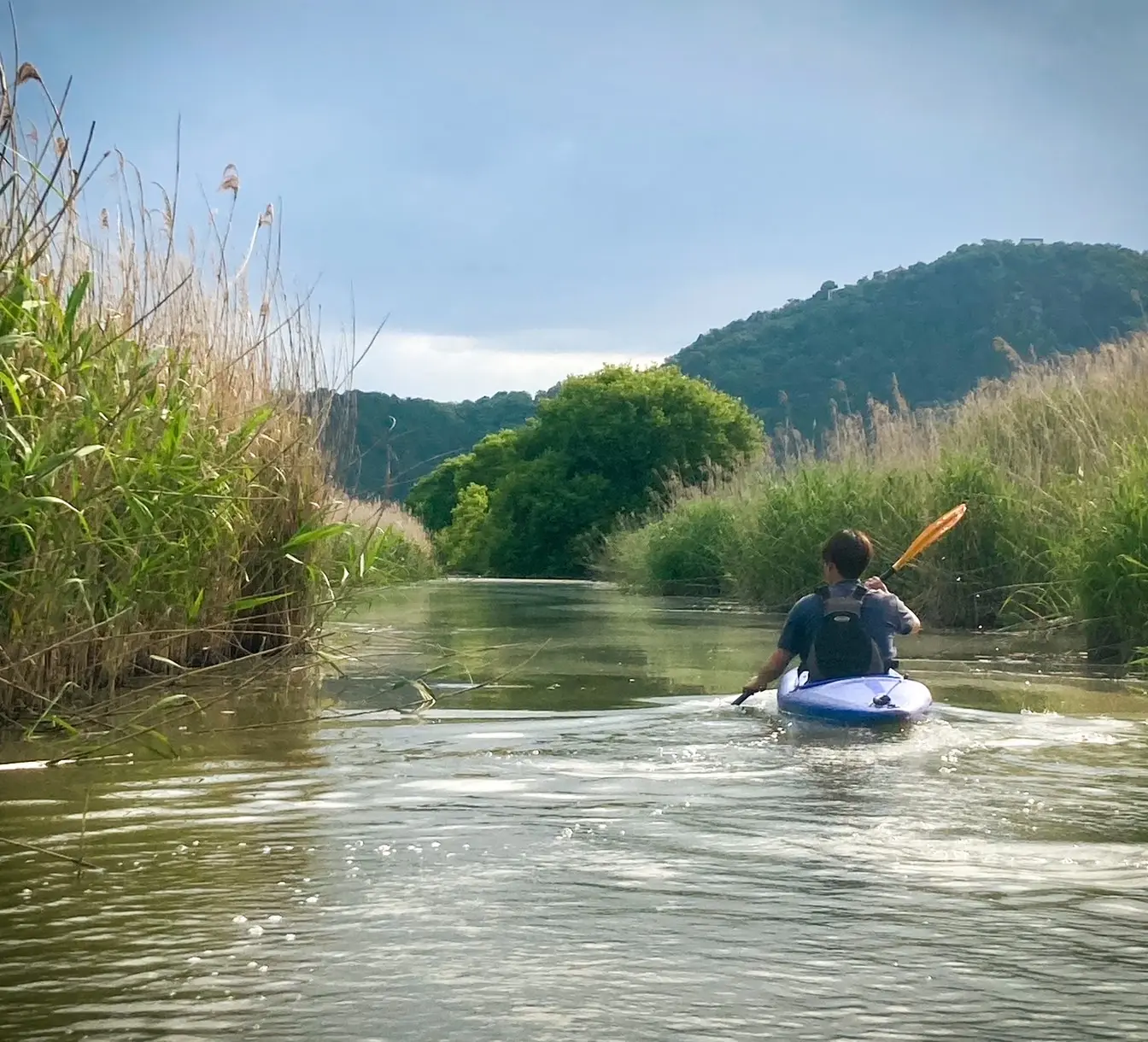
Heading toward one of Lake Biwa’s original landscapes, the vast reed beds (Yoshi-hara Zone).
The first destination on day two is a water activity experience. From JR Ōtsu Station, take an easy ride on the Kosei Line to Ogoto-Onsen Station. A 15-minute walk will bring you to “Opal", one of the largest water activity and nature learning facilities on Lake Biwa.
Check-in at the front desk and get ready for your big adventure with a wardrobe change into water-friendly wear. This activity is a kayak tour exploring Lake Biwa, complete with a thorough paddling lesson beforehand so even beginners can feel at ease.
Set out for the Yoshi-hara Zone, a vital reed bed ecosystem that plays a key role in purifying the lake's water and serving as a habitat for diverse wildlife. Many fans love the chance to paddle and get up close to glimpse lake fish and birds in an intimate glimpse only available from a kayak.
The tour includes photo opportunities on the water, and after returning, an exclusive craft activity using Yoshi paper, further deepening our connection to the natural environment. Well-rounded from start to finish, count on this activity to bring you to unforgettable memories hugged by the beauty of Lake Biwa.
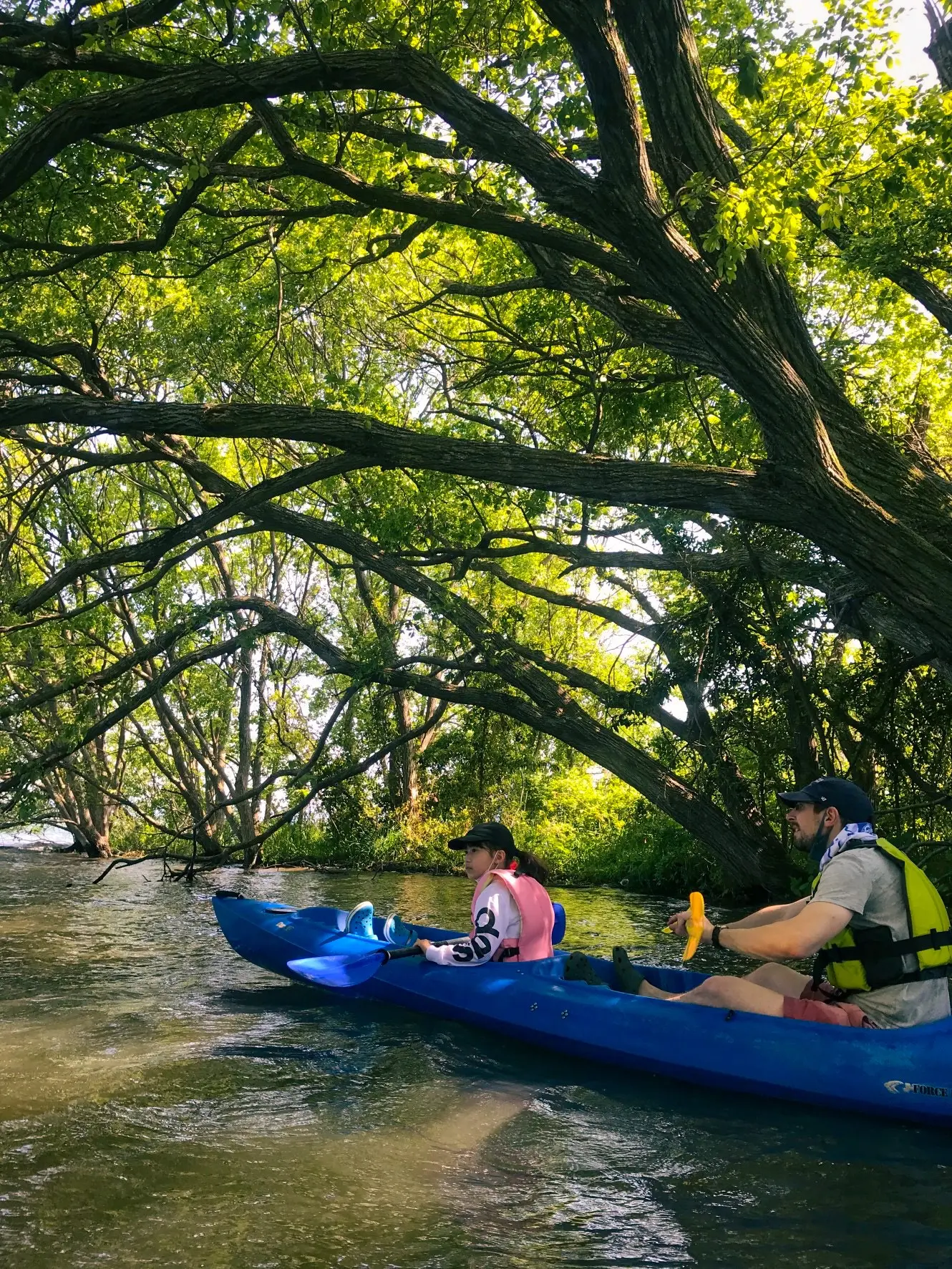
Paddling forward while observing a wide variety of plants and wildlife in their natural habitat.
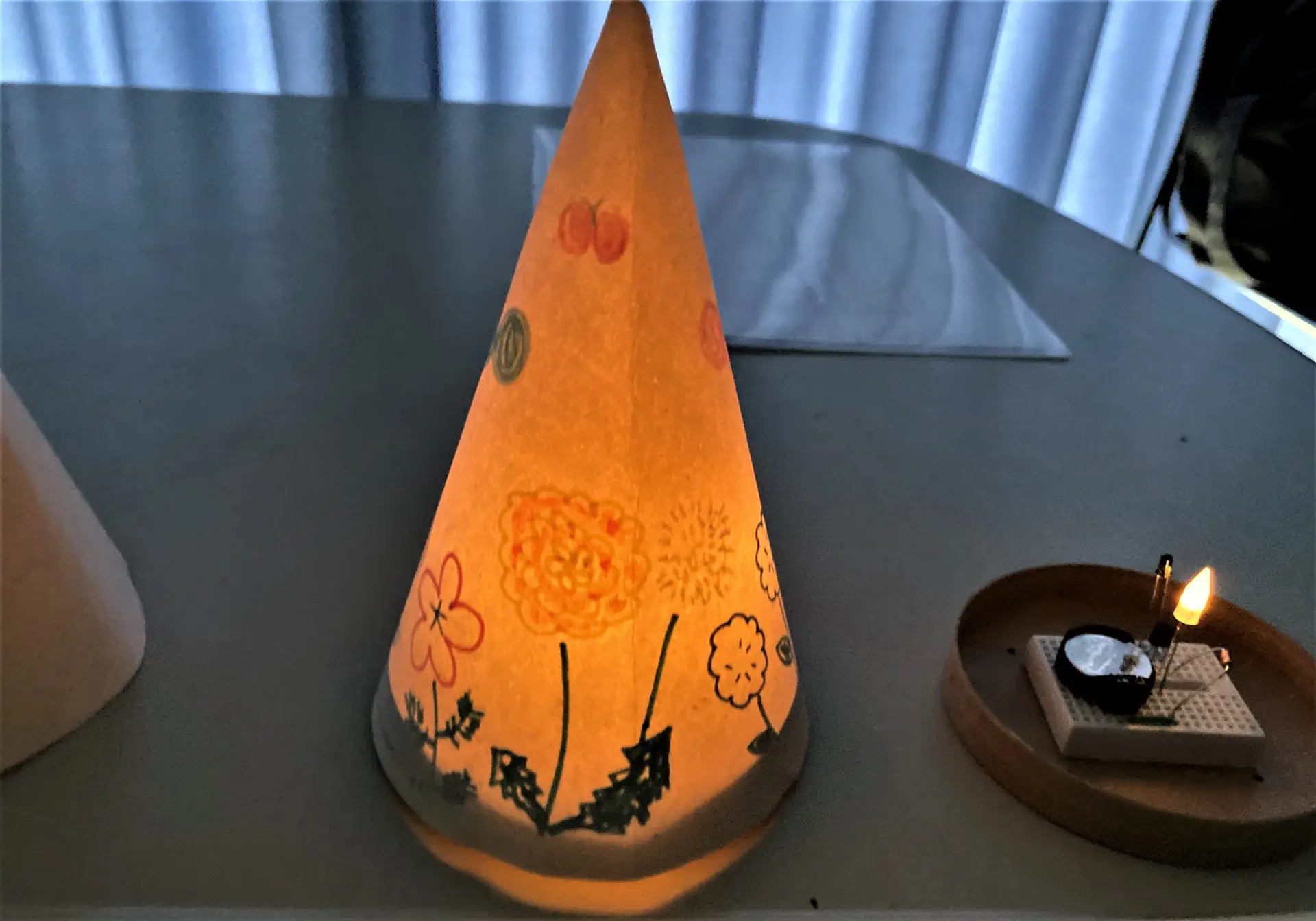
Creating an LED lampshade using Yoshi paper, which is made from harvested and processed reeds from the Yoshi-hara Zone.
Details
- Name in Japanese
- エコブルーツアー「びわ湖の多様な自然を満喫!アドベンチャーカヤックツアー」
- URL
- URL(English)
12:20pm – Lunch at Teuchi Soba Tsuruki, a Fames Hand-Cut Soba Restaurant in the Hieizan Area
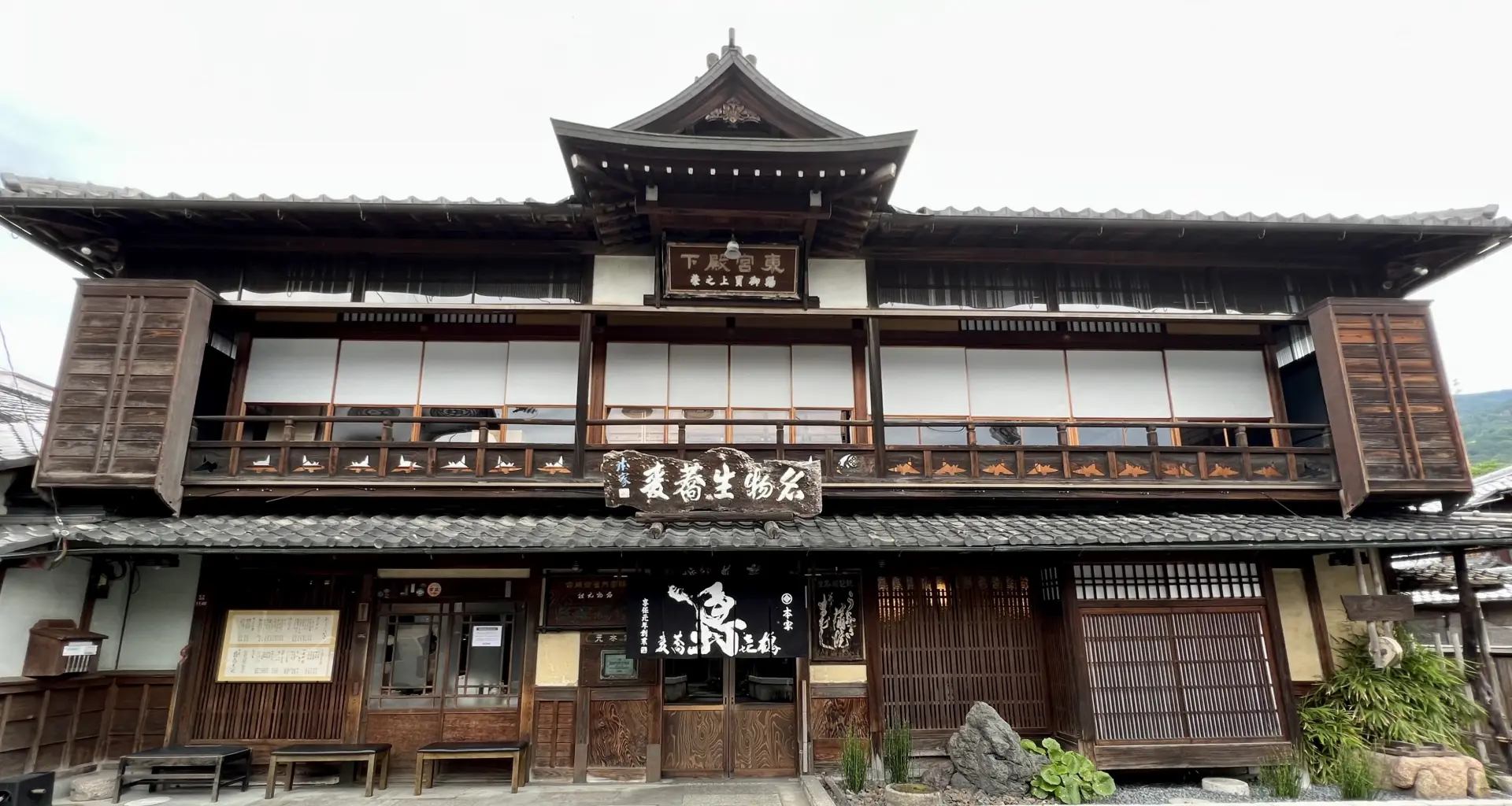
A renowned restaurant in Sakamoto, Ōtsu City, the monzen-machi (temple town) of Hieizan Enryakuji.
Delight your inner child with a time on the lake before heading to a much-anticipated lunch break. From Ogoto-Onsen Station, take the JR Kosei Line to Hieizan-Sakamoto Station, stepping into the Hieizan area, which spans both Ōtsu City and Kyoto City.
Founded in 1716 by Kakuya Kihachi, a monk of Hieizan Enryakuji, this historic soba restaurant has preserved the traditional art of handmade soba for over 300 years.
The Sakamoto area, where the restaurant is located, has long served as the monzen-machi (temple town) of Hieizan Enryakuji, often referred to as the kitchen of the mountain. In the past, food was scarce on Mount Hiei, so monks would travel down to Sakamoto to make and deliver soba. There is also a legend that monks who had completed their Hieizan training valued soba as a gentle, nourishing food for their weakened stomachs. Over three centuries, this tradition remains cherished today by countless visitors.
The restaurant’s signature soba stands out for its meticulous selection and blending of buckwheat flour, resulting in a handcrafted texture that is astonishingly smooth from the very first bite. The dashi broth is a perfectly balanced blend of mackerel, urume sardines, mejika (young bonito), and thick-cut bonito flakes, enriched with Rishiri kelp and locally sourced soy sauce. Every detail is carefully crafted, making this a one-of-a-kind culinary experience—truly one of the highlights of our journey.
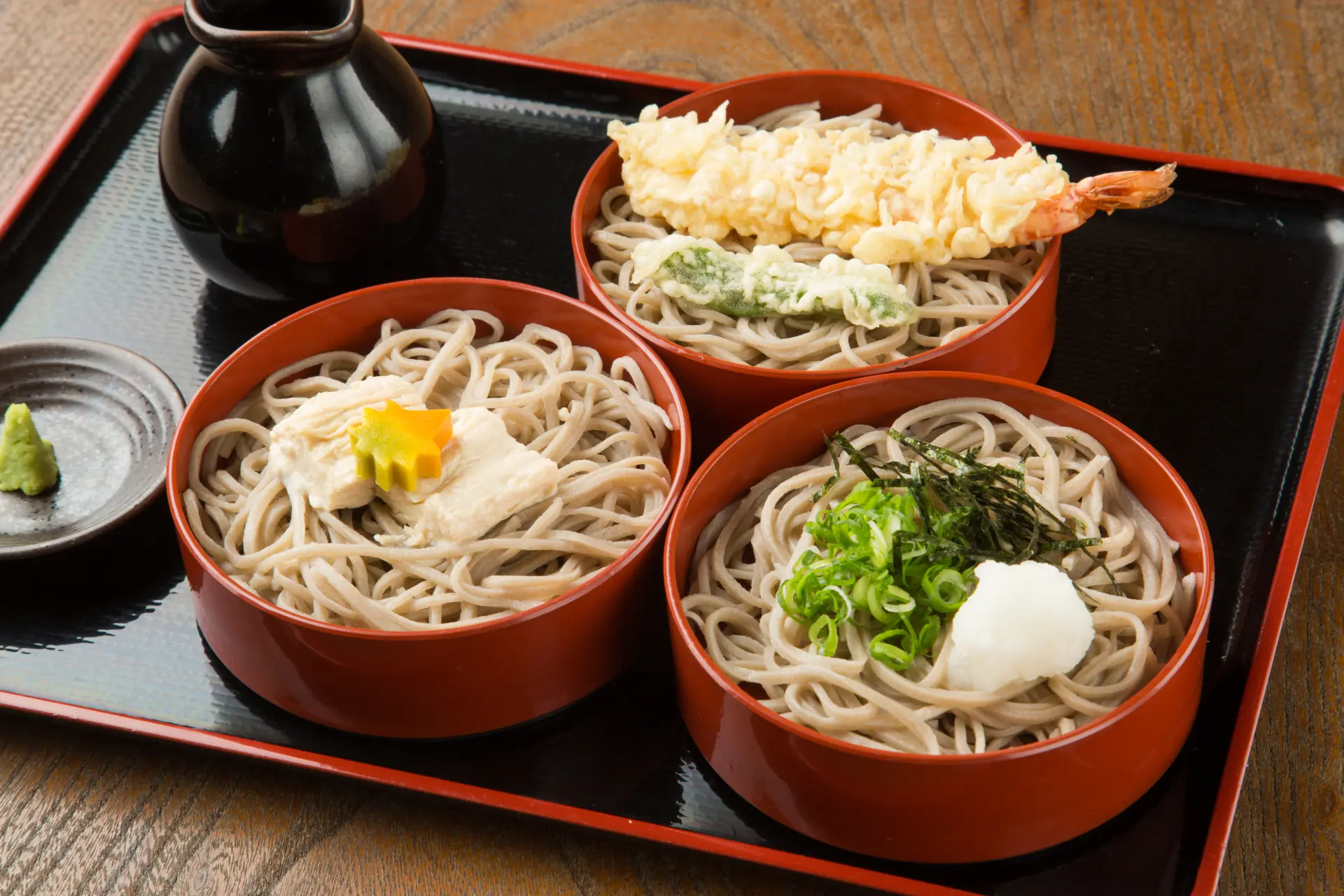
The restaurant's specialty, "Ōmi Musubi Soba", is crafted with the hope of fostering meaningful connections and good fortune through the delight of taste.
The menu offers a variety of choices, including the signature "Ōmi Musubi Soba" (1,860 yen), which allows you to enjoy three types of soba: tempura soba with shrimp, soba with Hiei yuba and namafu (wheat gluten cakes), and grated daikon soba. Another highlight is the "Kamo Nanban Soba" (1,980 yen), made with Ōmi duck from Takashima, Shiga Prefecture.
The restaurant itself is housed in a traditional irimoya-style building constructed around 1887 (Meiji 20), which has been designated as a Registered Tangible Cultural Property. While waiting for your soba, take a moment to feast your eyes on the picture-perfect garden view, making the time pass in an instant.
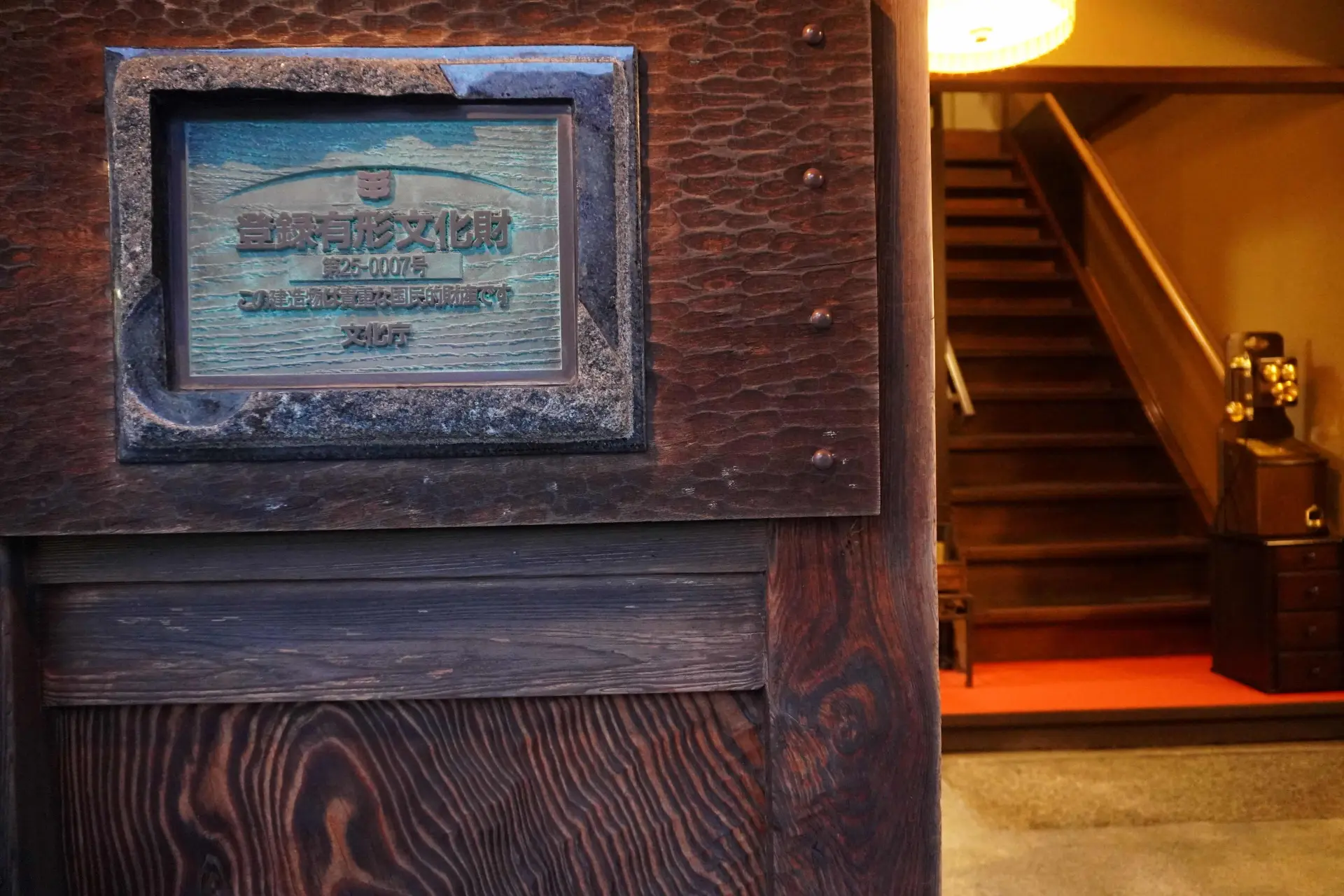
A Registered Tangible Cultural Property that hums with timeless legacy in every corner.
Details
- Name in Japanese
- 手打蕎麦鶴㐂
- Postal Code
- 520-0113
- Address
- 4-11-40 Sakamoto, Otsu City, Shiga
- Telephone
- 077-578-0002 (Please avoid calling between 11:00am - 3:00pm)
- Access
-
(1) 3-minute walk from Keihan Hieizan-guchi Station
(2) 10-minute walk from JR Hieizan-Sakamoto Station
(3) 10-minute walk from Cable Sakamoto Station
(4) 2-minute drive from Route 161 Sakamoto-Kita IC - Hours
-
11:00am - 4:00pm (L.O.3:30pm)
* subject to seasonal changes—please check the official website - Closed
- New Year's Day, plus other holidays as listed on the official website.
- URL
- URL
2:00pm – Ride Japan’s Longest Cable Car, the Sakamoto Cable, to Reveal Inspiring Views of Hieizan and Lake Biwa
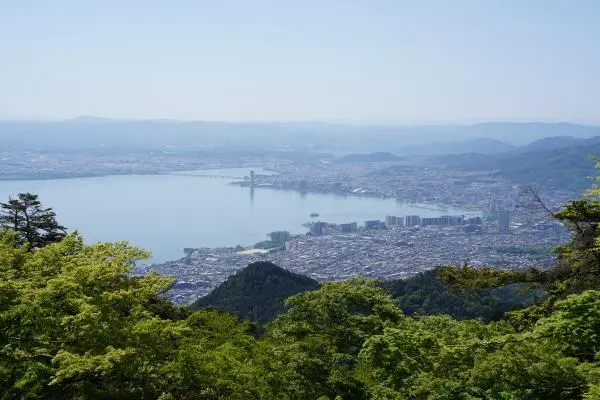
The Yama no Deck observation terrace at Cable Enryakuji Station offers a jaw-dropping panoramic view of Hieizan and Lake Biwa.
After a sumptuous feast its time to set out again on a journey to Hieizan Enryakuji, a vast temple complex spanning the entire 848-meter-high Mount Hiei. Given its expansive grounds, first-time visitors are recommended to take the cable car for a comfortable ascent.
The Sakamoto Cable, as it is called, holds the distinction of being Japan’s longest cable car, covering approximately 2 kilometers in length. The ride to Cable Enryakuji Station takes about 11 minutes, offering a chance to immerse yourself in the rich natural beauty of Mount Hiei. As the summit nears, see as a stunning panoramic view of Lake Biwa emerges and takes your breath away.
Both Cable Sakamoto Station at the base and Cable Enryakuji Station at the summit have historical station buildings that retain their original charm from their opening in 1927. These structures are designated as Registered Tangible Cultural Properties of Japan, adding to the experience.
Upon arrival at Cable Enryakuji Station, make your way to the observation terrace for a moment face-to-face with spectacular scenery. For centuries, the people living near Lake Biwa have not only expressed gratitude for the blessings of water but also believed that pure streams possess spiritual energy. Even at Hieizan Enryakuji, water-related rituals are held, underscoring the deep reverence for Lake Biwa. Gazing out over its magnificent expanse, we can truly appreciate how this belief has been cherished and passed down through generations.
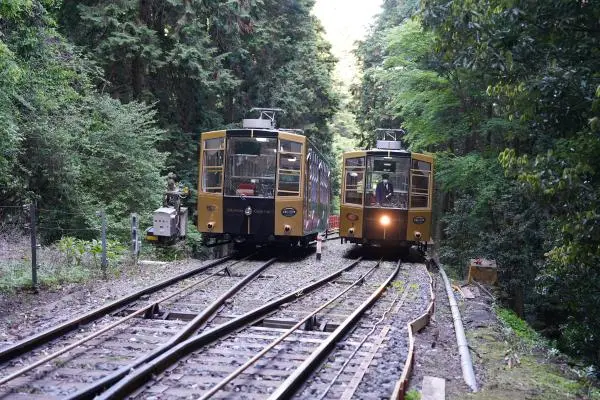
At the midpoint of the journey, be sure to watch for the "turnout", where the ascending and descending cable cars pass each other—a fascinating highlight of the ride!
Details
- Name in Japanese
- 坂本ケーブル
- URL
- URL(English)
2:20pm – Experience 1,200 Years of Legend at the World Heritage Mountain Temple, Hieizan Enryakuji
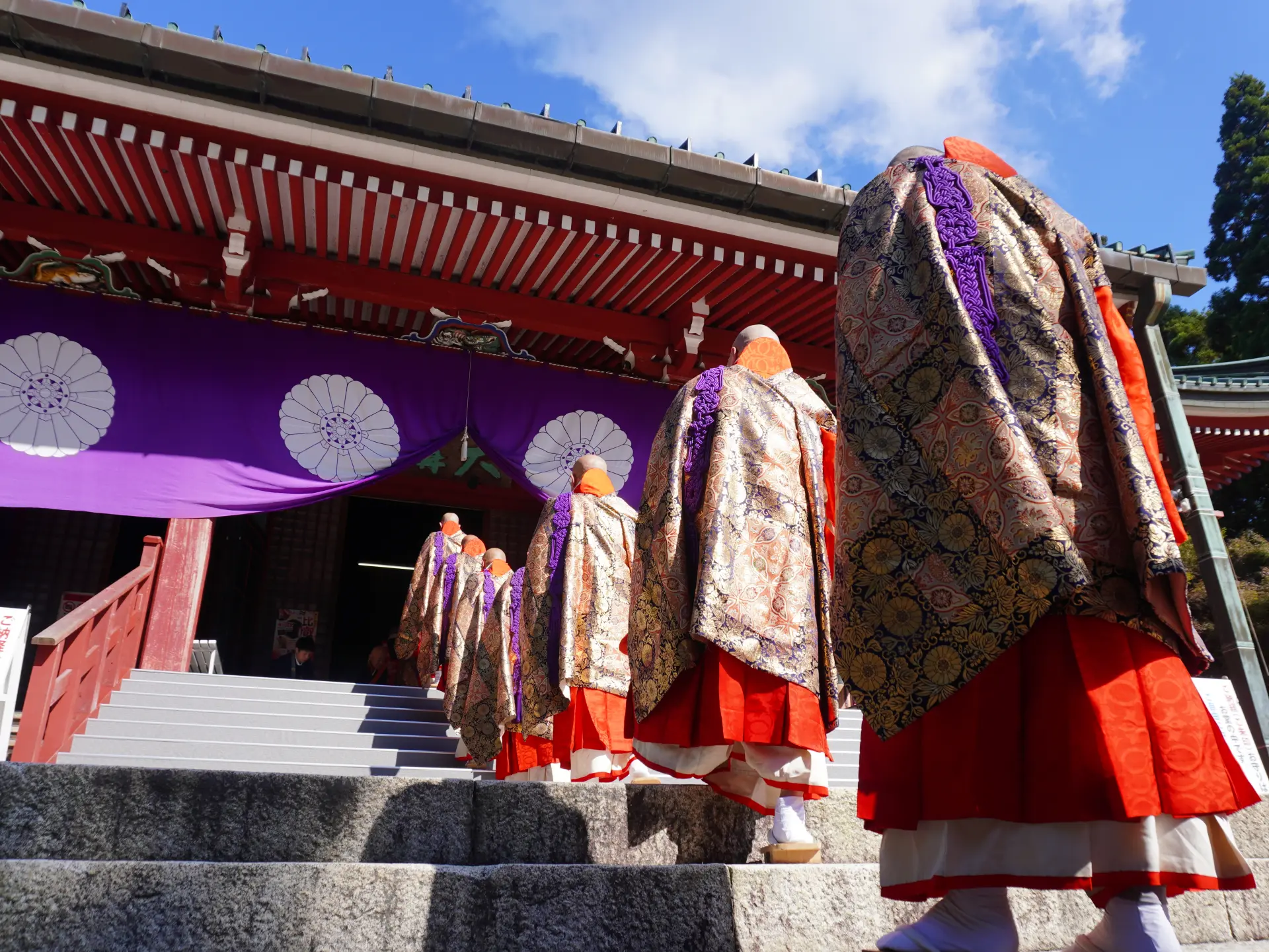
Since its founding, Hieizan Enryakuji has remained a sacred training ground, and its solemn atmosphere continues to resonate to this day.
Taking the cable car and disembarking at Cable Enryakuji Station, before an easy, 10-minute stroll to the final destination of our journey: Hieizan Enryakuji.
Founded in 788 (Enryaku 7) during the late Nara period by Saichō, Enryakuji is the head temple of the Tendai sect. Known as a renowned center for Buddhist training, it has produced many of Japan’s most influential monks, including Hōnen, Shinran, and Nichiren, who later founded their own Buddhist schools. Because of its role in shaping Japanese Buddhism, Enryakuji is often referred to as the "Mother Mountain" of Japanese Buddhism. In 1994, it was inscribed as a UNESCO World Cultural Heritage Site.
The temple complex is divided into three main areas: Tōdō (East Pagoda), Saitō (West Pagoda), and Yokokawa, covering an expansive 100-kilometer perimeter and a temple ground spanning approximately 1,700 hectares.
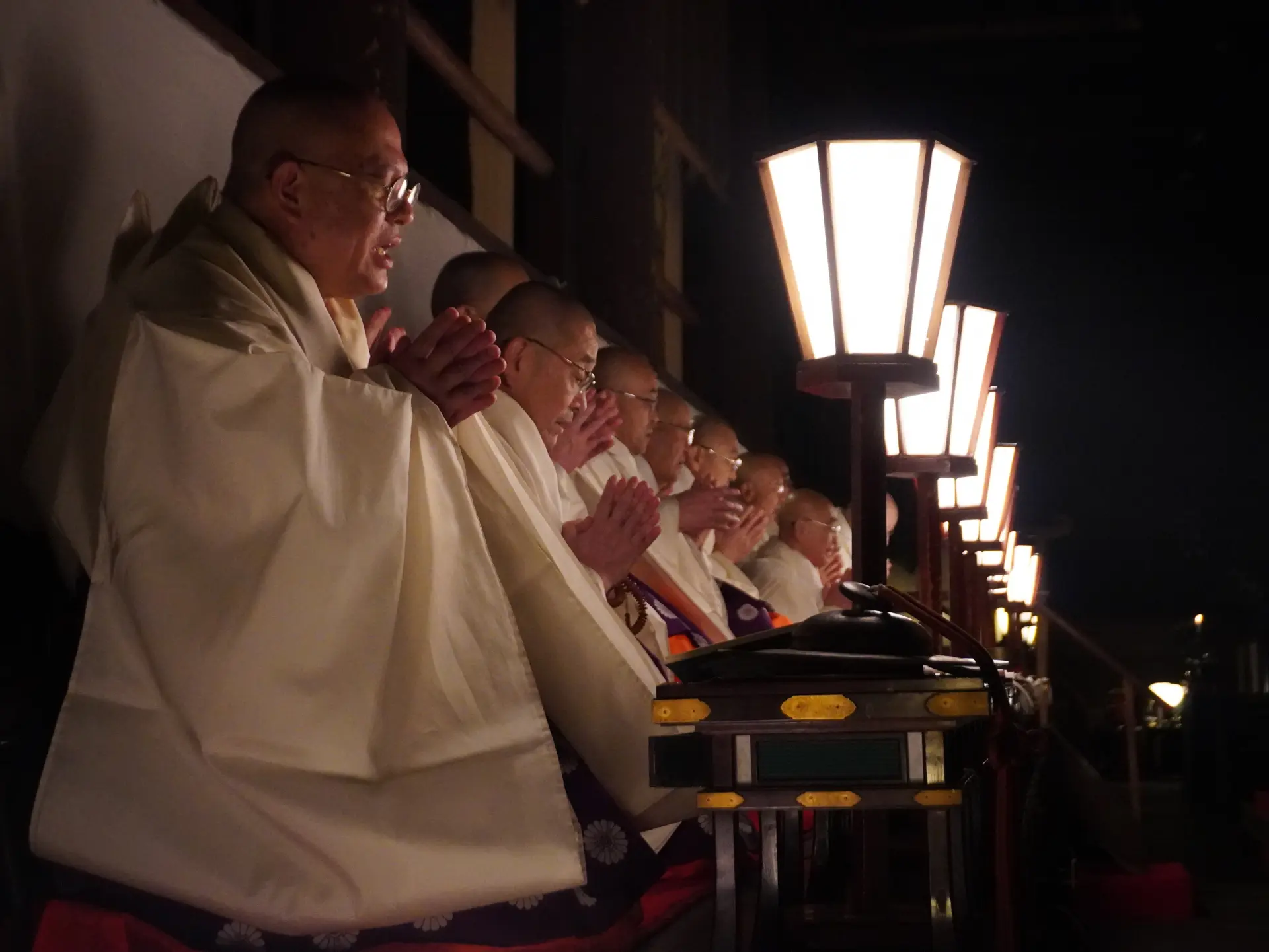
Depending on the timing of your visit, you may have the opportunity to witness a solemn Buddhist ceremony, experiencing the temple’s sacred atmosphere firsthand.
In the Tōdō (East Pagoda) area, the most iconic structure is Konpon Chūdō, the largest temple hall in Enryakuji. Inside, the "Eternal Dharma Light" (Fumetsu no Hōtō) has been continuously burning for 1,200 years, offering a deep sense of peace and spiritual comfort.
At the National Treasure Hall (Kokuhōden), various cultural artifacts from Enryakuji’s long history are preserved and displayed, including Buddhist statues, paintings, and calligraphy, providing an insightful glimpse into the temple’s heritage.
In the Saitō (West Pagoda) area, visitors can find Shakadō (Tenpōrindō), the oldest structure in Enryakuji. This historic hall houses a statue of Shakyamuni Buddha, which is said to have been personally crafted by Saichō. The solemn atmosphere, infused with the spirit of the Sengoku period (Warring States era), naturally instills a sense of reverence and focus.
Meanwhile, the Yokokawa area is home to Yokokawa Chūdō, the main hall of this district. Its design is inspired by a Tang dynasty envoy ship, and its unique elevated stage-like construction gives the impression of floating in midair. The temple’s harmony with its surrounding natural beauty is awe-inspiring, evoking a profound sense of reverence for both architecture and nature.
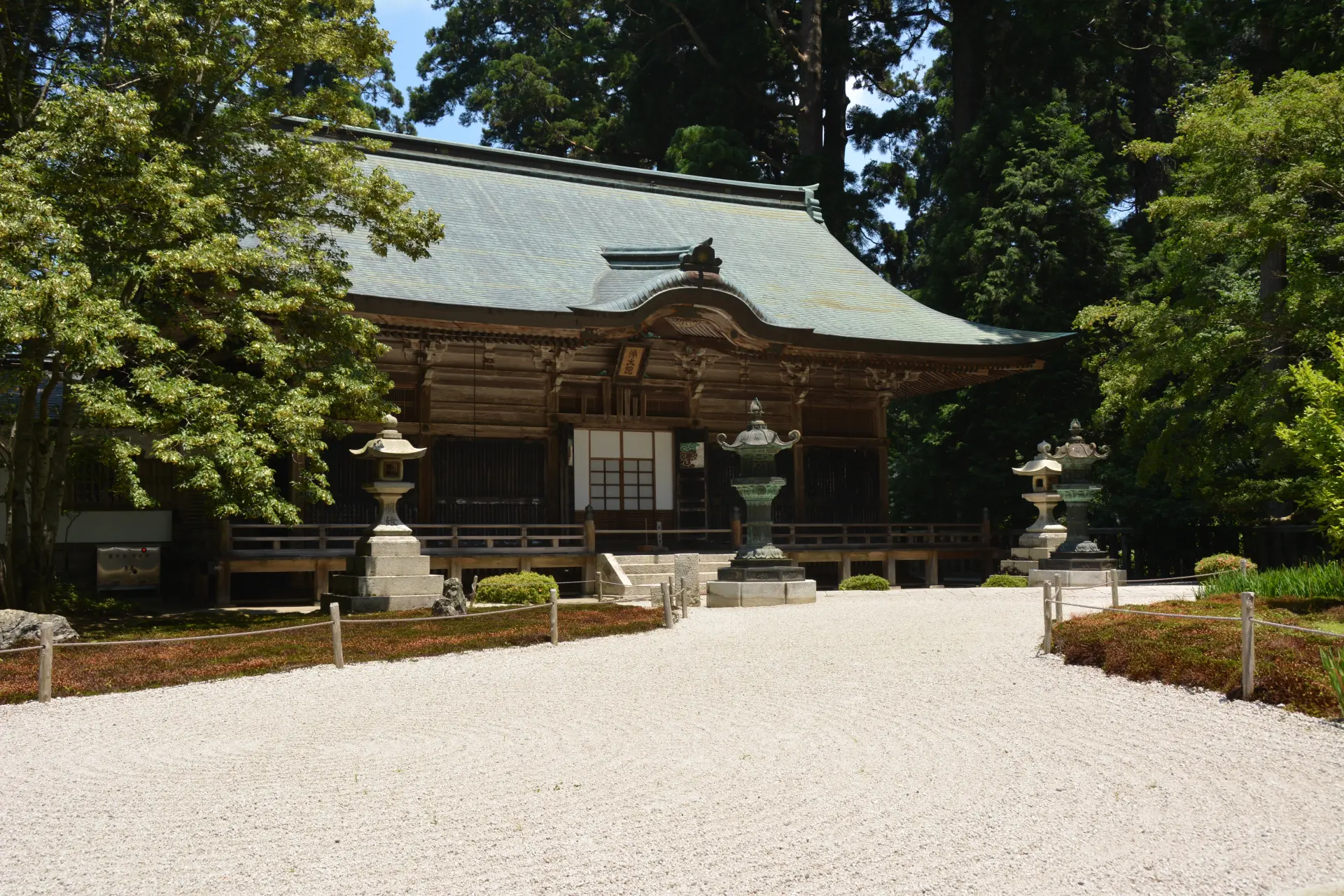
Jōdō-in, located in the Saitō (West Pagoda) area, is designated as a National Important Cultural Property of Japan.
Including these iconic structures, Hieizan Enryakuji is home to over 150 temple buildings, and a thorough visit takes approximately four hours. This particular course highlights some of the more significate stops that are especially worthwhile for first-time visitors.
To efficiently explore the three main areas, utilizing the shuttle bus—which runs every 30 minutes—is highly recommended. The fare is 700 yen one way or 1,000 yen for a one-day pass (limited operation from early December to January, and service is suspended from January to mid-March).
Beyond admiring timeless architecture and sacred traditions, a visit to Enryakuji also offers a chance to immerse oneself in natural, picturebook beauty of each season, providing a profoundly rejuvenating experience for both body and soul. Hieizan Enryakuji is truly a place where history and nature intertwine, creating a luxurious retreat into Japan’s spiritual and cultural heritage.
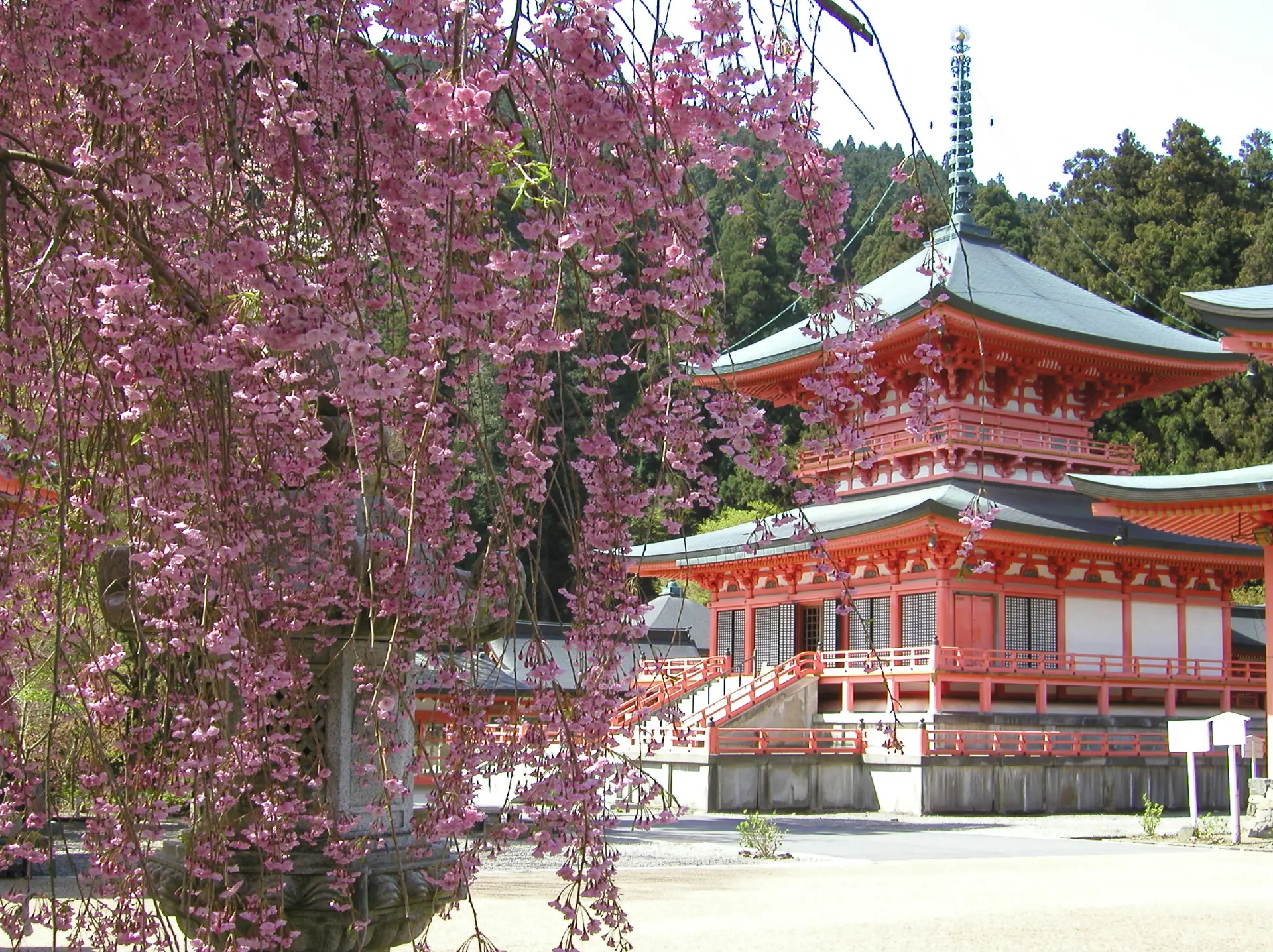
Hokke Sōji-in Tōtō, located in the Tōdō (East Pagoda) area, is beautifully adorned with weeping cherry blossoms in the spring.
Details
- Name in Japanese
- 比叡山延暦寺
- URL
- URL(English)
Wrap-up
Step into scenes of traditional Japanese life shaped by water and see how Lake Biwa’s teeming waters have inspired an abundant day-to-day, plus the long legacy of a sacred mountain temple on this 1-night, 2-day foray across Shiga’s multifaceted destinations.
With each season bringing a new and unique beauty, this region promises a fresh experience every time you visit. Treat yourself to a chance to see, feel, and embrace the captivating essence of Shiga for yourself.
Check also...
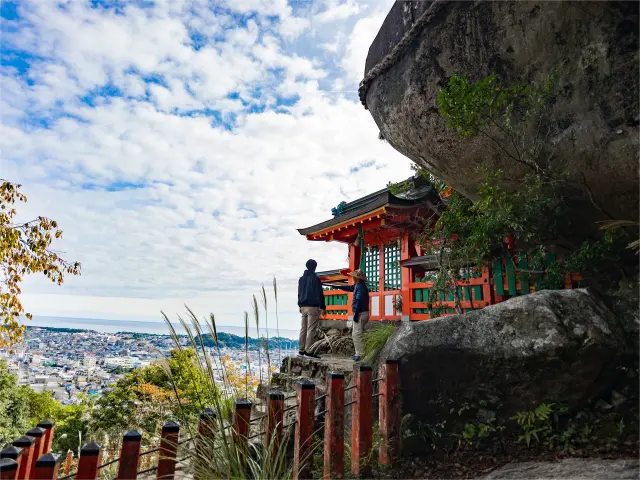
Wakayama: A World Heritage Site and Journey of Deep Mystique at the Kumano Kodo
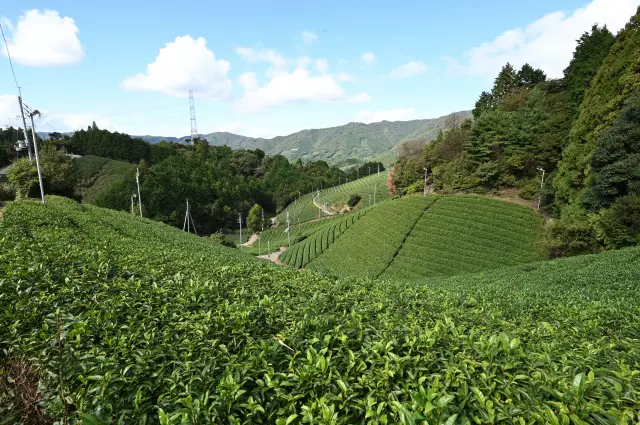
Kyoto: A Journey Through Japanese Gastronomy
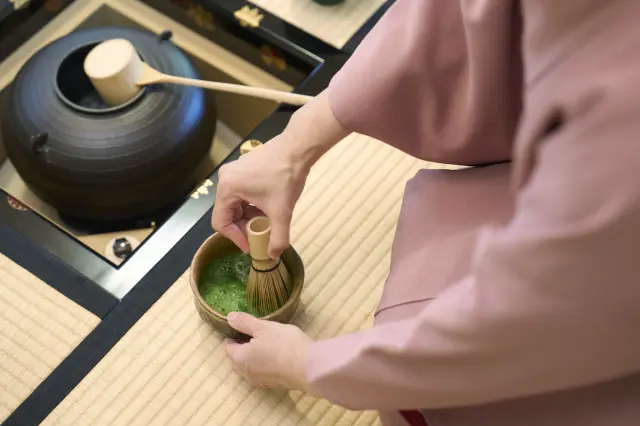
Osaka: A Journey Through Traditional Osaka
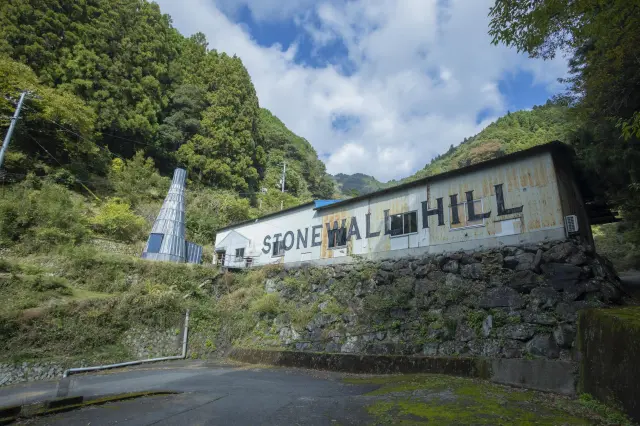
Tokushima: A Journey into Slow Living in the Mountains of Tokushima
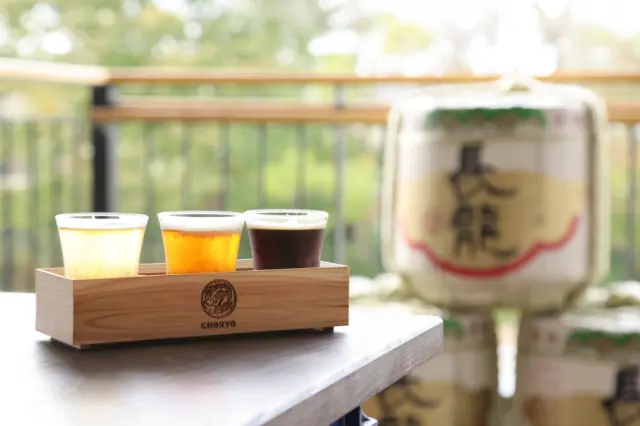
Nara: A Journey Through Its Ancient Fermentation Culture
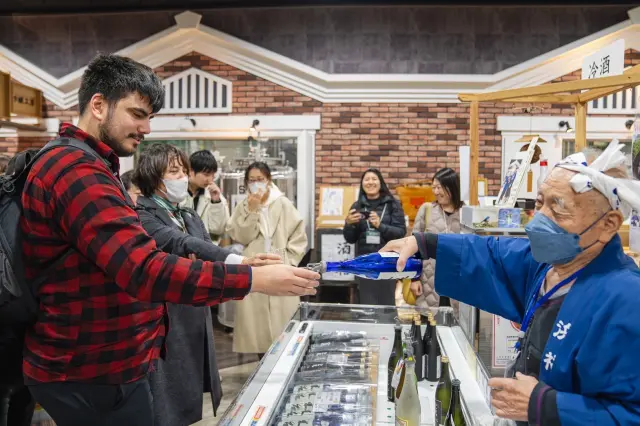
Hyogo: A Journey in Search of Japan’s Finest Sake
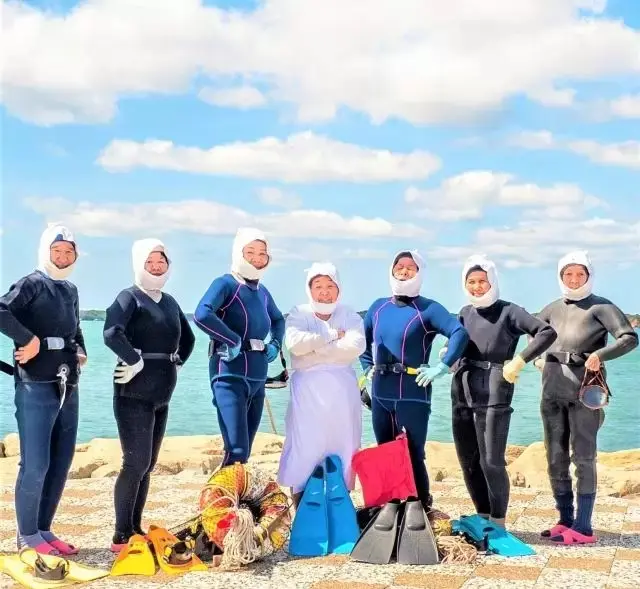
Mie: A Journey to Experience the "Ama Culture" Living Along the Beautiful Ise-Shima Sea
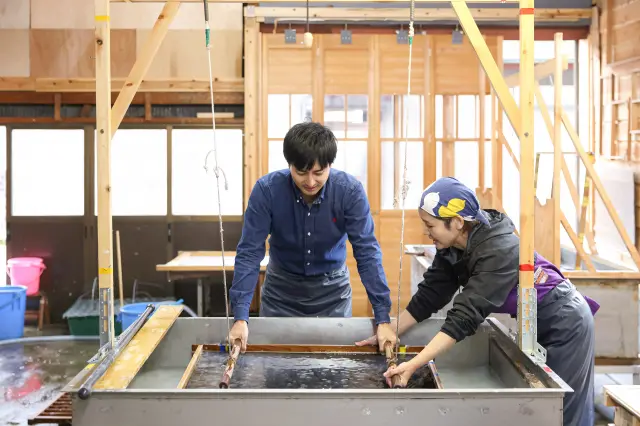
Fukui: A Journey to Experience Japan’s World-Class Craftsmanship
